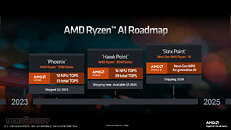- Joined
- Oct 9, 2007
- Messages
- 47,647 (7.44/day)
- Location
- Dublin, Ireland
| System Name | RBMK-1000 |
|---|---|
| Processor | AMD Ryzen 7 5700G |
| Motherboard | Gigabyte B550 AORUS Elite V2 |
| Cooling | DeepCool Gammax L240 V2 |
| Memory | 2x 16GB DDR4-3200 |
| Video Card(s) | Galax RTX 4070 Ti EX |
| Storage | Samsung 990 1TB |
| Display(s) | BenQ 1440p 60 Hz 27-inch |
| Case | Corsair Carbide 100R |
| Audio Device(s) | ASUS SupremeFX S1220A |
| Power Supply | Cooler Master MWE Gold 650W |
| Mouse | ASUS ROG Strix Impact |
| Keyboard | Gamdias Hermes E2 |
| Software | Windows 11 Pro |
GIGABYTE released UEFI firmware (BIOS) updates for its Socket AM5 motherboards encapsulating the AMD AGESA ComboAM5 PI 1.1.0.1a microcode. This latest version of AGESA has sparked speculation that some of AMD's upcoming Ryzen 8000G desktop APUs are in fact based on the newer "Hawk Point" silicon, and not "Phoenix." AMD released its Ryzen 8040 series "Hawk Point" mobile processors earlier this month, with a faster NPU that results in an up to 40% increase in AI interference performance over that of "Phoenix." "Hawk Point" is essentially identical to "Phoenix," including its first generation XDNA architecture based NPU, however the NPU's clock speed has been dialed up. If AMD is building some of its Ryzen 8000G desktop APU models on "Hawk Point" instead of "Phoenix," then we have our first solid hint that AMD is bringing Ryzen AI to the desktop platform, and that the Ryzen 8000G will end up being the first desktop processors with an NPU.
AMD is expected to be building at least two APU models based on the "Hawk Point" silicon, the Ryzen 7 8700G, and the Ryzen 5 8600G. The lower models, namely the 8500G and Ryzen 3 8300G, are expected to be based on the smaller "Phoenix 2" silicon, with a hybrid CPU that combines two "Zen 4" cores with up to four "Zen 4c" cores. The "Zen 4c" cores may feature an identical instruction set architecture (ISA) and IPC to the regular "Zen 4" cores, but have tighter Vcore limits, and operate at lower clock speeds. This makes the two available "Zen 4" cores the de facto "performance" cores, and AMD flags them as UEFI CPPC "preferred cores," ensuring the OS guides a bulk of its processing traffic to them. Both "Phoenix" and "Hawk Point" feature an identical CPU setup, with up to eight "Zen 4" cores.

View at TechPowerUp Main Site | Source
AMD is expected to be building at least two APU models based on the "Hawk Point" silicon, the Ryzen 7 8700G, and the Ryzen 5 8600G. The lower models, namely the 8500G and Ryzen 3 8300G, are expected to be based on the smaller "Phoenix 2" silicon, with a hybrid CPU that combines two "Zen 4" cores with up to four "Zen 4c" cores. The "Zen 4c" cores may feature an identical instruction set architecture (ISA) and IPC to the regular "Zen 4" cores, but have tighter Vcore limits, and operate at lower clock speeds. This makes the two available "Zen 4" cores the de facto "performance" cores, and AMD flags them as UEFI CPPC "preferred cores," ensuring the OS guides a bulk of its processing traffic to them. Both "Phoenix" and "Hawk Point" feature an identical CPU setup, with up to eight "Zen 4" cores.

View at TechPowerUp Main Site | Source



